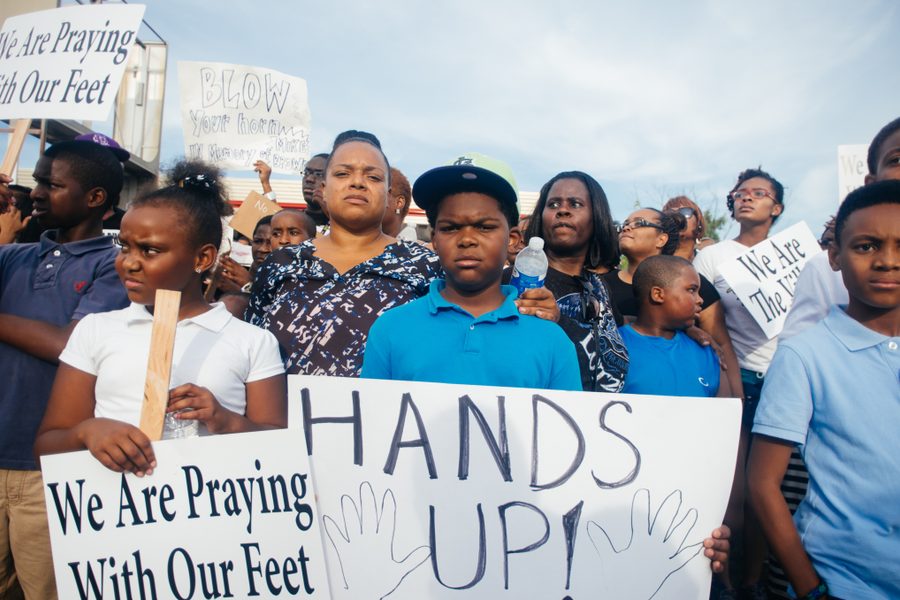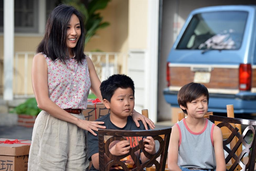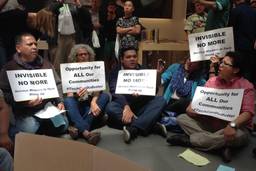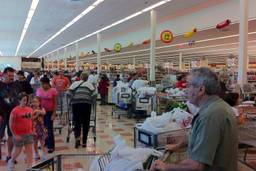As Ferguson ‘Weekend of Resistance’ Begins, Organizers Weigh How to Turn a Moment into a Movement
With thousands descending on Ferguson today to demand justice for Michael Brown, a creator of #BlackLivesMatter thinks now may be the time to win long-term victories.
Julia Wong

Thousands of activists are expected to converge on Ferguson, Missouri starting Friday, October 10, for a “Weekend of Resistance” to support the ongoing protest movement that arose in the wake of the police killing of Michael Brown on August 9. Ferguson October, as the initiative is called, was organized by a coalition of recently formed and longstanding community organizations in the St. Louis area, including Hands Up United, The Organization for Black Struggle and Missourians Organizing for Reform and Empowerment (MORE).
Beginning Friday with a march to the office of Bob McCulloch, the attorney charged with prosecuting the police officer who shot and killed Brown, the weekend will include numerous rallies, protests, political forums, and teach-ins, and will culminate with planned civil disobedience actions on October 13.
Alicia Garza is one of the organizers working on the ground in Ferguson with the wave of new activists who have taken to the streets in the wake of Brown’s killing. Based in Oakland, California, Garza is the Special Projects Director for the National Domestic Worker’s Alliance (NDWA). Garza is a co-creator of #BlackLivesMatter, a “political project” and online platform that aims to confront anti-black racism and reaffirm black humanity. Garza is also a member of LeftRoots, a “national formation of Left social movement organizers and activists” seeking to build socialism in the 21st century.
In the aftermath of Brown’s killing, Garza recalls feeling “not only completely horrified, but completely rageful.” She says, “Just like when any member of your family is hurt in any way, there’s a real urge to be there.” She responded to a “call coming from folks on the ground … for black folks in particular who were organizers and medics and attorneys and healers to come and support the community of Ferguson and the St. Louis community more broadly.”
With the backing of the NDWA, Garza traveled to Ferguson about three weeks after Brown’s death, and spent two weeks working “to help support capacity building on the ground.” During that time, the Black Lives Matter team organized a Freedom Ride that Garza says “mobilized more than 500 black people from all over the country to come to Ferguson, to not only stand in solidarity but to lend concrete and material support to organizers who work on the front lines of the Ferguson rebellion.”
Garza says her work in Ferguson was to “make sure the organizations and activists on the ground had the capacity to really hold this moment and extend it into a movement.”
After returning to the Bay Area, Garza received a call from the coalition organizing Ferguson October asking for support. On September 28, she returned to Ferguson, where she spoke with In These Times.
When you arrived in Ferguson, who were the people and groups on the ground that you ended up working with? What does the organizing look like?
Somebody who was born and raised in the Bay Area has the privilege of growing up in a place that has a long history of political activism and organizing and many institutions and organizations that exist to support social change. When I arrived here, there was a stark difference. Certainly there are quite a few organizations on the ground here that are organizing around various issues, but I learned very quickly that this moment was really different. In some ways, organizations here were grappling with how to show up in a moment where most people are in motion — for the most part, spontaneous motion — and it doesn’t look like our regular organizing work.
When I came here, first I started meeting people and getting to know the organizations on the ground and the work they were doing. There’s a great organization here that was founded after I arrived called Millennial Activists United, which is a really dynamic and incredible group of young women, many of whom are queer women, who are black, who have been some of the most creative and innovative forces on the ground. Other folks are doing really incredible work around labor rights like the young fast food worker activists from Show Me 15, who have also been on the front lines fighting for justice for Mike Brown.
My first two weeks were really about getting to know the landscape and having movement building conversations with folks. A moment like this is not predictable. It really tests our acumen around how we build relationships — across difference, with people that we don’t always like, with people we have political differences with. So I spent some time really sitting with folks and helping them strategize about how to send this from a moment into a movement.
In coming here the second time, I was asked to play somewhat of an organizing director role for a coalition of organizations and activists that have come together to fight for justice for Mike Brown. The plan was to create a weekend of resistance here with the goal of bringing thousands of people from across the country to Ferguson to participate in targeted civil disobedience actions and cultural activities, to have an opportunity to build relationships and solidarity with local organizations and activists and to develop strategies that folks can take home. My work here is training young organizers to go out into St. Louis and talk with folks about joining the movement, getting folks to commit to participating in the weekend of resistance as the first step in joining the movement — and figuring out if we can build some infrastructure that can be sustained long after this weekend.
You have a background in community organizing, but you’re now working with the NDWA. We’ve seen Richard Trumka, the president of the AFL-CIO, speak out about Ferguson, and the AFL-CIO and SEIU have endorsed Ferguson October. Do you see people making a connection between police violence, racism and economic issues, and do you think that workplace organizing has in important role to play here?
What was so important about Richard Trumka’s speech was that he was really trying to make the connection for labor that we have to be broader. We have to organize people from a perspective of their whole being, as opposed to narrowly identifying who people are and what they care about. The actual line that he used in his speech was, “One of our brothers, Darren Wilson, murdered our sister’s son, Lesley McSpadden.” Lesley McFadden is a UFCW member. She works at a local grocery store chain in the deli. Darren Wilson, of course, is a Ferguson police officer.
He was really trying to activate organized labor to see this as our issue. He’s addressing some dynamics that are real and in some ways really uncomfortable to talk about, one of which is there are tons of black workers here in St Louis who work for poverty wages, who live in communities that have been ravaged by poverty and racism. If we’re only organizing people around class issues, we’re missing a huge part of people’s experiences and a huge opportunity to galvanize people around a broader progressive agenda that can win big victories — not just for workers, but for all people who are on the margins.
When you look at folks who are participating in the rebellion, you see folks who are wearing Show Me 15 t-shirts. Those young people are making the connection between racism, poverty, and police and state violence. It points to an opportunity for us to make sure we’re addressing issues of racism in our communities and connecting racism to poverty and exploitation.
As the National Domestic Workers Alliance — which represents 10,000 or more women of color or immigrant women in a largely informal sector doing invisible work that holds our country together — that’s a no-brainer. We understand the role of gender, race, and class are intricately connected. It’s really the face of the new labor movement. What’s happening in St. Louis is exciting because folks on the ground are making that connection — and waiting for the rest of us in the progressive movement to also make those connections so we can build a stronger movement that can actually win impactful, long lasting victories for our people.
This moment is a real opportunity, and it’s up to all of us whether we’re going to take advantage of it or not. People here are asking questions about relevance and effectiveness; they really want to win. They’re not standing any more for the okey-doke.
When you say people want to win — what does justice look like to them? What are people’s bigger picture demands?
People are talking about victories that are larger than Darren Wilson. They are talking a lot about ensuring that we transform policing in this country, and particularly in St Louis. And people are talking about really striving to challenge the systems of white supremacy and racism that pervade almost everything. And they’re talking about making sure that the leadership of young women of color is being elevated, which I think is brilliant, and can really serve as a beacon for all of us.
There are a number of socialist organizations endorsing and taking part in the weekend of resistance, including the International Socialist Organizion, Socialist Alternative and LeftRoots. What is a useful role for leftists to play in the struggle in Ferguson? How do you navigate your different roles an organizer with NDWA, Black Lives Matter and LeftRoots? Do you think having an explicitly leftist orientation is important to this work or should it be put aside in this moment?
I do think it’s important to enter into any space as a leftist. But I also acknowledge — and think it’s important for all of us to acknowledge — that the history of the Left in this country has been one that, in some ways, has been fairly disconnected from the real struggles that are happening in black communities, immigrant communities, communities of color and other oppressed groups. That’s because it has predominantly been a space of white men. When many people think of leftists, they think of white men selling newspapers who are going to tell you what you should think and how you should make revolution happen now.
What Third World liberation movements showed this country was that people make the road by walking—that we need to be guided by strong vision and a strong, disciplined practice, but we also need to be nimble and humble and flexible. For me, it’s important to lead with my politics, but the way that I do that is by showing up. Certainly there are still sects in this country that think that the way that revolution happens, the way that social transformation happens, is by talking about it to death, or by “instigating action.” I think what’s really important when we’re talking about sustained transformation is that people have to be really invested. People really have to believe in it. And people have to actually have a practice that is also transformative.
For me, as someone who wears many hats, I actually see them as one and the same. My work with domestic workers — who are largely women of color and immigrant women, who are poor and low-income — is really similar to my work with Black Lives Matter, which is lifting up the humanity and centrality of black lives in this country as a vision and a portal for the future… which is really similar to my work with Left Roots, which is about building a strong, vibrant left that’s rooted in communities of color and women and queer folks and others who have traditionally been on the margins, and really developing the strategies we need to build effective, long-term, sustained social transformation.
You frame Ferguson as a moment that needs to become a movement. Where on the path towards becoming a movement do you think activists in Ferguson are and what needs to happen next to keep moving in that direction?
I think people are getting stronger, they’re getting sharper, they’re getting smarter, and that’s really inspiring. The feeling here is both one of anticipation and one of commitment and dedication. There’s a lot of buzz around the weekend of resistance. Most people that we’ve talked to are really excited and are down to join the movement make history together.
The other feeling that I get in Ferguson is one of real hope and resilience. People have not forgotten. It’s been sixty days of continued and ongoing resistance. People have faced some of the ugliest shit that they could, and they’re still here. There’s a real sense of vibrancy and resilience — especially from young people, who are putting their lives on the line to make sure that this doesn’t go away.







